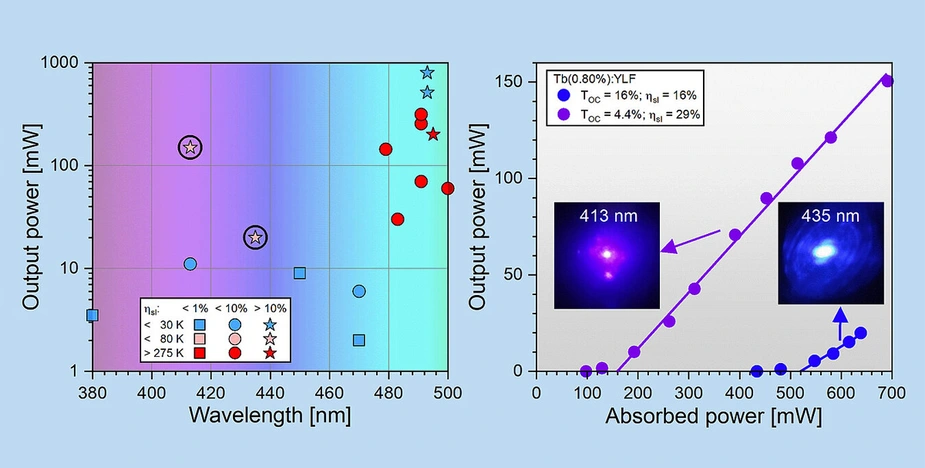New violet laser developed at IKZ
Researchers at the Center for Laser Materials (ZLM) at the Leibniz-Institut für Kristallzüchtung (IKZ) have developed the most efficient direct violet-emitting solid-state laser
Lasers with short-wave visible light in the blue or violet range have many practical applications. They are used in metalworking, for example, especially with metals such as copper, which strongly reflect infrared light but absorb blue-violet light. They are also needed in microscopy to excite fluorescent phosphors. In addition, UV radiation in the UV-C range can be generated comparatively easily from such lasers by doubling the frequency.
Even though blue-violet laser diodes based on the semiconductor material InGaN already exist, solid-state lasers offer clear advantages such as a better beam quality and the possibility for simple integration of additional functions such as intracavity frequency doubling.
The ZLM researchers' new laser uses trivalent terbium (Tb3+) as the laser-active element, which is incorporated into the matrix of the host crystal lithium yttrium fluoride (YLF) as a dopant during the growth process. Two previously unused transitions in the terbium ion are used to generate blue-violet laser radiation at 413 nm and 435 nm.
Terbium has already been used successfully by ZLM researchers for green and yellow lasers. For these new transitions, however, the usual doping concentrations of Tb3+ in the range above 10 % lead to cross-relaxation, which unintentionally depopulates the upper laser level. To avoid this effect, the researchers reduced the concentration of terbium to below 1 %.
In addition, the terbium-doped laser crystal (Tb:YLF) was cooled with liquid nitrogen during the experiments. Under these conditions, the laser yielded remarkable results: At 413 nm, it achieved an efficiency of 29 % with a continuous wave output power of 150 mW. At 435 nm, the efficiency was 16 % with an output power of 20 mW.
These values can be significantly improved in the future by optimizing the doping concentration and the reflection properties of the mirrors in the laser system. But even without these improvements, the performance of the new solid-state laser already exceeds previous systems with a similar wavelength, which moreover needed cooling to significantly lower temperatures, by a factor of more than ten.
The results were recently published in the journal Optics Letters:
M. Badtke, S. Kalusniak, H. Tanaka, and C. Kränkel, Tb:YLF laser at 412.7 nm and 435.1 nm, Opt. Lett. 50 (11) (2025), https://doi.org/10.1364/OL.553252
Contact:
Dr. Christian Kränkel
Leader ZLM
Center for Laser Materials (ZLM)
+49 30 246499-613
christian.kraenkel(at)ikz-berlin.de
Press release IKZ, 9 May 2025
